
Most freshwater bass fans are well aware that bigmouths eat frogs but many are reluctant to toss croaker imitations. Perhaps that’s because frog patterns are usually used in heavily weeded areas, or maybe it’s because timing the strike takes a little getting used to before hook-up ratios grow more consistent. Whatever the reason, if you’ve avoided tossing croakers you’ve been missing out on one of the best methods of separating lunker largemouths from their most cherished sanctuaries. From weedy Forge Pond, Patchogue Lake and Massapequa Reservoir to the more open waters of Lake Ronkonkoma and Fort Pond in Montauk, frogs can be a top producer in your late summer arsenal.
One misconception about froggin’ for bass is that the technique should be reserved for use in the thickest of cover. While frogs are a great way of pulling big bass from lilies, hydrilla and cabomba fields, I also find them productive in wide open water. I especially like to toss these lures in four to six-foot depths on large flats where a few straggly stalks of water lilies are barely holding on for dear life or, perhaps, where a couple of aging stumps rise up to within a foot or two of the surface. I find that bass often transition around such structure, using it as way points when cruising between shallows and deeper water. They’ll also station themselves in such areas under cloudy skies. In either case, these fish can be frustratingly difficult to tempt with fast-moving lures like spinnerbaits and crank baits, but they’ll warm up to a frog worked steadily across the surface with an occasional pause.
Generally I’ll begin by wading or positioning my boat a long cast from the target so as not to spook any potential lunkers. The presentation is simple: let the frog land with a big, fat splat to announce its presence, then let it sit for a spell. Depending on the aggressiveness of your quarry, allow the frog to rest for four or five seconds or as much as a full minute before bringing it to life with a slight twitch or two followed by enough rest to let the ripples to clear. At that point, the retrieve begins in earnest with three or four “pops” followed by a two- or three- second rest and another round of pops.

As a rule, the more aggressive the bass seem to be on any given day, the quicker and more steady the retrieve pace necessary. On the best days, no rest is needed between pops. In fact, you can even walk the dog with these lures, although it takes a little practice to get the motion just right.
DIG ‘EM OUT
Undoubtedly, the application for which weedless topwater frogs are best known is probing shallow, weedy waters that are unfishable by most other means. Size up the thickest grass mats, most impenetrable lilies and phragmite or cattail lined shorelines and you are looking at prime froggin’ territory.
In this situation, you can pop your offering along the weed edges or across small pockets. Many anglers have success by casting a few feet beyond an opening and dragging the lure back into the pocket. That’s all fine and productive but for summertime action I actually prefer to flip and pitch my frogs just like a jig & pig. I’ll pick a large lily leaf or dense head of grass at the edge of a channel, drop a frog right on top and then just let it set for a few seconds. Eventually, I’ll twitch it softly or maybe even lift it up and set it back down in the same spot several times. The idea is to build up anticipation in the fish before I slide the frog out into a space where it can be attacked. This produces some of the most vicious bass strikes imaginable. Develop the patience to make this presentation work and you’ll actually be able to sense the frustration in a fish as it waits and waits for a chance to grab its meal. Finally given the opportunity, a waiting lunker will rarely miss.
Another presentation that works well with topwater frogs is to toss them right up onto the shore, then hop them back into the water. Again, let you lure rest at first, then offer a slight twitch and second short rest before beginning the retrieve. On those late June and early July days when real frogs are hopping into the water as you work along a shoreline edge, this technique can bring about some awesome responses.
WAIT FOR THE TURN
One mistake that novice froggers often make is striking too quickly. It’s understandable when you consider that the attack can be so flagrant but the end result is almost always a fish that misses the lure or shakes free on the first jump.
To really put the point to a hungry bass, let the fish completely engulf your lure and turn away from the ambush point. This allows the frog to be swallowed deeply enough for the hook-set to stick. I usually bow to the fish on the strike, dipping my rod tip almost to the water before setting back with a strong strike. Some anglers use a count of three before reacting but I find my timing is better with the dip. Either way, cross the fish’s eyes and get it up and out of the cover as quickly as possible.
Of course, how and where you present weedless topwater frogs determines th tackle you’ll need. For working shallow flats with minimal cover you can get awa with a medium-action spinning stick and eight- to 12-pound test line. For probin deep in the slop fields or tight to weed-choked shorelines conventional style flippin and pitchin’ gear spooled with 14 to 30-pound test line will serve much better. In either case, tie the frog directly to the main line. Adding a snap, swivel or heav leader will make the lure slightly nose-heavy and rob it of proper swimming action

TOP FROGS
Some bass fans swear by a particular brand of weedless frog, but I’ve found tha most of them work just fine in the hands of experienced anglers. More important to me is the color choice. Green, yellow, white and black are all on the recommended list.
As for specific brands, you’ll score well with Snag-Proof frogs, Spro’s Bronzey (affectionately known as Kermit,) and Paycheck Baits Transporter Frog, among others. Each of these are weedless-style hollow-bodied frogs that collapse on impact to reveal their hooks. Soft-plastic frogs, which ride lower on the surface but offer striking fish a more realistic flesh-like feel are generally referred to as toads. These are also worth investigating, especially if you have a lot of faith in working weedless worms, crayfish, lizards and similar soft plastics. Check out Strike King’s Rage Toad and Zoom’s Horny Toad to see if you prefer this style. Both of these can also be used just under the surface with addition of a small bullet weight ahead of the hook.